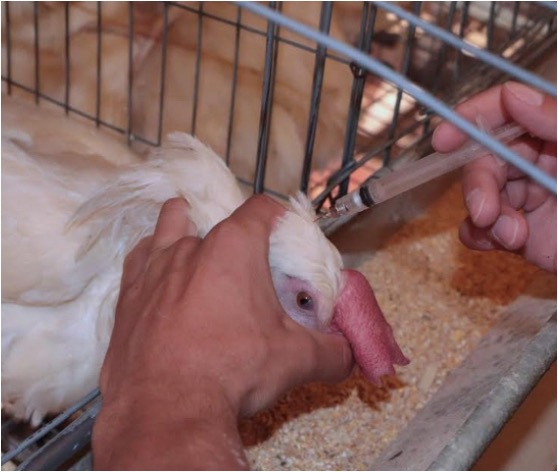Reframing histories of vaccine development through non-human animal lenses
02/12/2024 | Reflections
Author: Alexis Bedolla Velázquez
Editor: Mariana Pitta Lima
Birds, bats, mosquitoes, rodents, pigs. In the modern epidemiological imagination, these non-human animals, their bodies and waste, are often conceived as bearers of potential catastrophe. When accounting for the origins of pandemic diseases such as Influenza, Ebola, Zika, or Covid it seems almost inevitable to encounter scientific narratives that portray animals as little more than ‘epidemic villains’ (Lynteris, 2019). In this post, I argue for the need to transgress these familiar epidemiological representations by analyzing a case of vaccine development from a non-human animal perspective.
More than just villains
In contrast to widespread epidemiological conceptions that vilify non-human animals, critical approaches have sought to move beyond the politics of animal blame. Drawing on frameworks such as political ecology (Gandy, 2022), One Health (Cassidy, 2018; Kirk & Worboys, 2011), and multispecies justice (Celermajer & McKibbin, 2023; Kirksey, 2020), an increasing number of scholars advocate for reconceptualizing modern pandemics as phenomena that extend beyond the mere transmission of diseases from animals to humans. Notably, these critical perspectives emphasize the need to reframe pandemics as complex and dynamic ecological processes, deeply shaped by capitalist and colonialist practices.
Despite their transformative potential, the discourse and ethics surrounding One Health and multispecies relationships often fade away in the face of dangerous epidemic outbreaks. As it is possible to witness time and time again, pandemic scares immediately trigger measures of medicalization, surveillance, and extermination of non-human animals justified as necessary to protect humanity from zoonotic or vector-borne diseases.
Notwithstanding such tendencies to control and eliminate the usual animal suspects, it is possible to explore other kinds of scientific and technological practices that do not necessarily treat or assume animals as villains. Focusing on how non-human animals are key for human health and not just disease, I think, can enable us to engage with politics and stories that go beyond those related to practices of pandemic control.
Particularly regarding vaccines, harnessing these analytical lenses allows us to move away from trite topics like nationalism, geopolitics, disinformation or the prowess of Western technoscience and explore, instead, how animals are of vital importance for rethinking the production and politics of modern science and medicine. The case of the Mexican vaccine for Covid-19 — the focus of my current research project —, perhaps may serve as an illustration to exemplify this point.
¡Tenemos “Patria”!
In late 2020, the Mexican federal government launched an ambitious initiative to develop its own Covid-19 vaccine, named Patria (meaning 'motherland' in English). Funded by taxpayers, the project quickly sparked controversy. On one side, the Mexican president, Andrés Manuel López Obrador, promoted Patria as a symbol of 'technological sovereignty,' claiming it could be developed entirely with Mexican science and technology while offering a more cost-effective alternative to international options. Critics, however, viewedthe project as a misallocation of public resources driven by populist motives. They particularly criticized that the vaccine was being produced hastily and with outdated Covid-19 viral strains, limiting its effectiveness in providing meaningful immune protection.
Beyond such polarizing interpretations that have dominated the public discussion in Mexico, the story of the development of Patria appears much more nuanced, complex and interesting when viewed from the vantage point of non-human animals. For instance, focusing on the role of birds reveals their critical importance for Patria's molecular design. Particularly because its development was based on a vast, pre-existing international scientific network centered on the study of the Newcastle disease virus (NDV). This specific avian virus, extensively investigated for over a century in veterinary science due to its highly contagious and lethal effects on birds, was selected to design the Mexican vaccine because of its effectiveness, adaptability, and affordability as a viral vector and vaccine platform.
Similarly, shifting the focus from governments and humans to the pigs, hamsters, and mice necessary for the preclinical trials of Patria reveals the often-overlooked material and economic networks that sustain the use of model organisms in vaccine development. And even more so, focusing on Patria’s industrial production highlights the pivotal role of chicken eggs, which served as indispensable agents in the process. In countries like Mexico—and many others in the Global South—where the scientific infrastructure needed to produce next-generation mRNA vaccines is lacking, chicken eggs still function as the essential biochemical reactors that make large-scale vaccine production possible. Because of this reason, it was not a global pharmaceutical corporation but a local private veterinary company that took on the critical task of manufacturing millions of doses of Patria; a company named, tellingly, Avimex.
Recognizing in this sense the crucial role that nonhuman animals have played in the development of Patria can thus open the door not only to creative forms of analysis, but also to disruptive political considerations. In particular, this perspective may help us transcend traditional STS vaccine narratives (see Bach, 2019; Stocco, 2022; Valladares, 2022) by foregrounding the role of non-human animals as living entities, with their own histories and unintentional capacity to effect historical change. It can help us rethink, moreover, how animals hold varying epistemic, technological, and political value within local technoscientific assemblages and networks.
Therefore, beyond the celebrated narratives of vaccine development by major pharmaceutical companies like Pfizer, Moderna, and AstraZeneca, it is essential to explore how focusing on non-human animals uncovers overlooked material and symbolic interconnections that underpin the production of contemporary medical treatments. This perspective highlights the agency of animals in shaping the history and evolution of modern science, epidemiology, and medicine. More importantly, it challenges the individualistic and anthropocentric ontologies and ethical frameworks that dominate Western theories and practices of justice, opening pathways to rethink our relationships with the more-than-human world.
Alexis Bedolla Velázquez holds a PhD in Sociology from the University of Bristol and is an Associate Researcher at UNAM in Mexico City. From a decolonial and anti-racist approach, he studies contemporary epidemic science and pandemic preparedness technologies. He can be contacted at alexis.bedolla@unam.mx
Published: 12/02/2024


